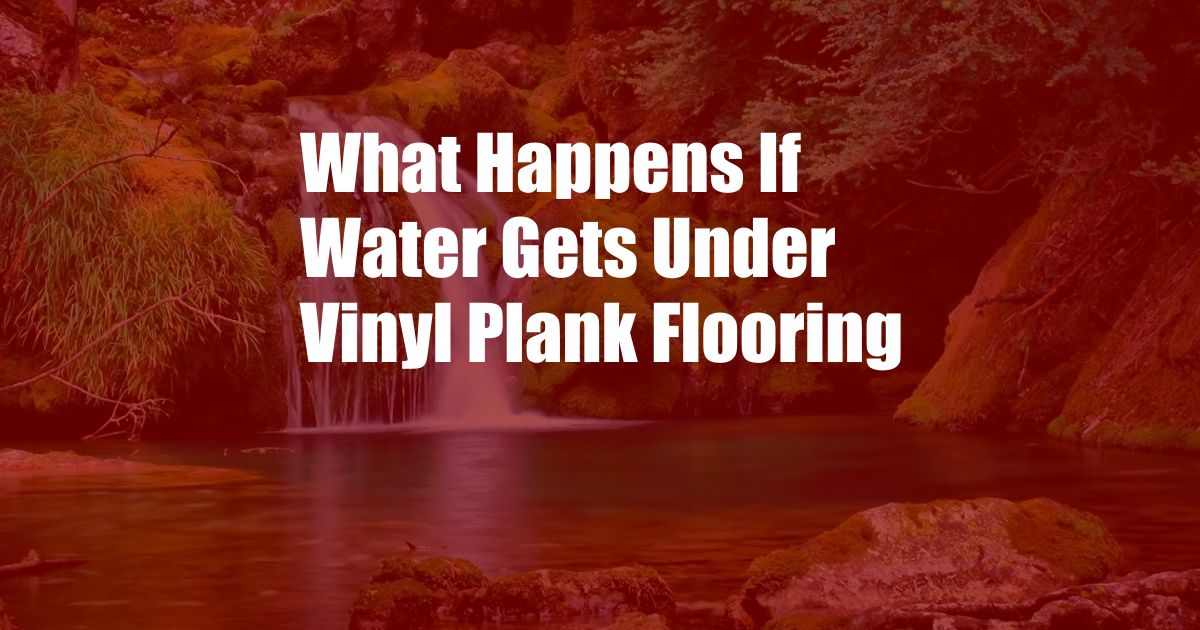
Water Infiltration Under Vinyl Plank Flooring: A Comprehensive Guide
In the realm of home renovation and flooring, vinyl plank flooring has gained immense popularity for its durability, ease of maintenance, and aesthetic appeal. However, as with any building material, water intrusion can pose a significant threat to its integrity. This article delves into the consequences of water seeping under vinyl plank flooring, exploring the potential damage, preventative measures, and expert advice to mitigate such situations.
Imagine the scene: you’ve meticulously installed your new vinyl plank flooring, only to discover telltale signs of water damage. The once-pristine surface buckles, discolors, and even harbors mold growth. The culprit? Water that has stealthily infiltrated beneath the planks, wreaking havoc on your flooring investment.
Understanding Vinyl Plank Flooring: A Water-Sensitive Surface
Vinyl plank flooring consists of multiple layers, including a rigid core, a decorative printed layer, and a protective top layer. While the top layer acts as a barrier against spills and everyday wear, it’s not entirely waterproof. If water manages to penetrate this surface and reach the core, it can cause irreversible damage.
The core of vinyl plank flooring is typically made of wood, which is naturally susceptible to water absorption. When water seeps into the core, it swells, causing the planks to buckle and warp. Additionally, water trapped beneath the flooring provides an ideal breeding ground for mold and mildew, compromising indoor air quality and creating a potential health hazard.
The Perils of Water Under Vinyl Plank Flooring
Water infiltration under vinyl plank flooring can lead to a myriad of problems, including:
- Buckling and Warping: As mentioned earlier, water absorption causes the core of the planks to swell, leading to buckling and warping of the surface.
- Discoloration: Water can also cause discoloration of the flooring, as it seeps into the decorative layer and alters its pigments.
- Mold and Mildew Growth: The moisture trapped beneath the flooring provides a fertile environment for mold and mildew to flourish, releasing harmful spores into the air.
- Loss of Structural Integrity: Prolonged water exposure can weaken the structural integrity of the flooring, making it prone to cracking and breaking.
- Health Hazards: Mold and mildew spores can trigger allergic reactions, respiratory issues, and other health problems.
Preventing Water Damage: A Proactive Approach
To safeguard your vinyl plank flooring from water damage, it’s crucial to adopt proactive measures:
- Proper Installation: Ensure that the flooring is installed according to the manufacturer’s instructions, with proper underlayment and moisture barriers.
- Use of Waterproof Vinyl Plank Flooring: Opt for waterproof vinyl plank flooring specifically designed to withstand water exposure.
- Immediate Cleanup of Spills: Clean up any spills on the flooring promptly to prevent water from seeping into the seams or under the planks.
- Regular Inspections: Regularly inspect your flooring for any signs of water damage, such as buckling, discoloration, or mold growth.
- Maintenance and Cleaning: Follow the recommended cleaning and maintenance guidelines to keep the flooring in optimal condition and prevent water penetration.
Expert Tips and Advice for Water Damage Mitigation
In the unfortunate event of water seeping under your vinyl plank flooring, swift action is essential. Here’s expert advice to mitigate the damage:
- Immediate Water Removal: Use towels or a wet/dry vacuum to remove as much water as possible from the surface and beneath the planks.
- Ventilation and Drying: Open windows and doors to ventilate the area and promote drying. Use fans or dehumidifiers to accelerate the drying process.
- Inspection and Assessment: Once the flooring is dry, carefully inspect the affected area for any damage, such as buckling, warping, or mold growth.
- Professional Repair or Replacement: If the damage is significant, it may require professional repair or replacement of the affected planks.
- Mold Remediation: If mold has grown, it’s essential to seek professional mold remediation services to safely remove it and prevent its spread.
Frequently Asked Questions on Vinyl Plank Flooring and Water Damage
Q: Can vinyl plank flooring be waterproof?
A: Yes, some vinyl plank flooring is specifically designed to be waterproof and can withstand water exposure. However, it’s essential to check the manufacturer’s specifications for specific waterproof capabilities.
Q: What are the signs of water damage under vinyl plank flooring?
A: Signs of water damage may include buckling or warping of the planks, discoloration, mold growth, and a musty odor.
Q: Can I repair water-damaged vinyl plank flooring myself?
A: Minor water damage may be repairable by replacing the affected planks. However, for more extensive damage, professional repair or replacement is recommended.
Q: How can I prevent mold growth under vinyl plank flooring?
A: Regular cleaning and maintenance, prompt cleanup of spills, proper ventilation, and addressing any sources of moisture will help prevent mold growth.
Conclusion
Water infiltration under vinyl plank flooring can have detrimental consequences, but with proper precautions and prompt action, it can be effectively mitigated. By understanding the risks, implementing preventative measures, seeking expert advice when necessary, and maintaining your flooring regularly, you can safeguard your investment and enjoy the beauty and durability of vinyl plank flooring for years to come.
If you’ve encountered water damage under your vinyl plank flooring, don’t hesitate to contact a qualified flooring professional for assistance. Their expertise will ensure that the damage is properly assessed and repaired, minimizing the impact on your flooring and overall home environment.